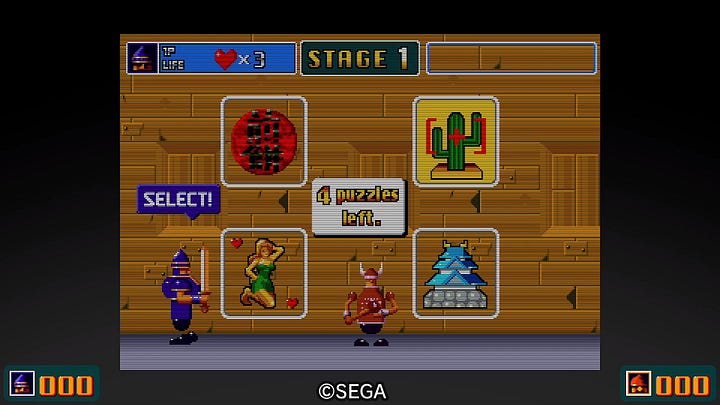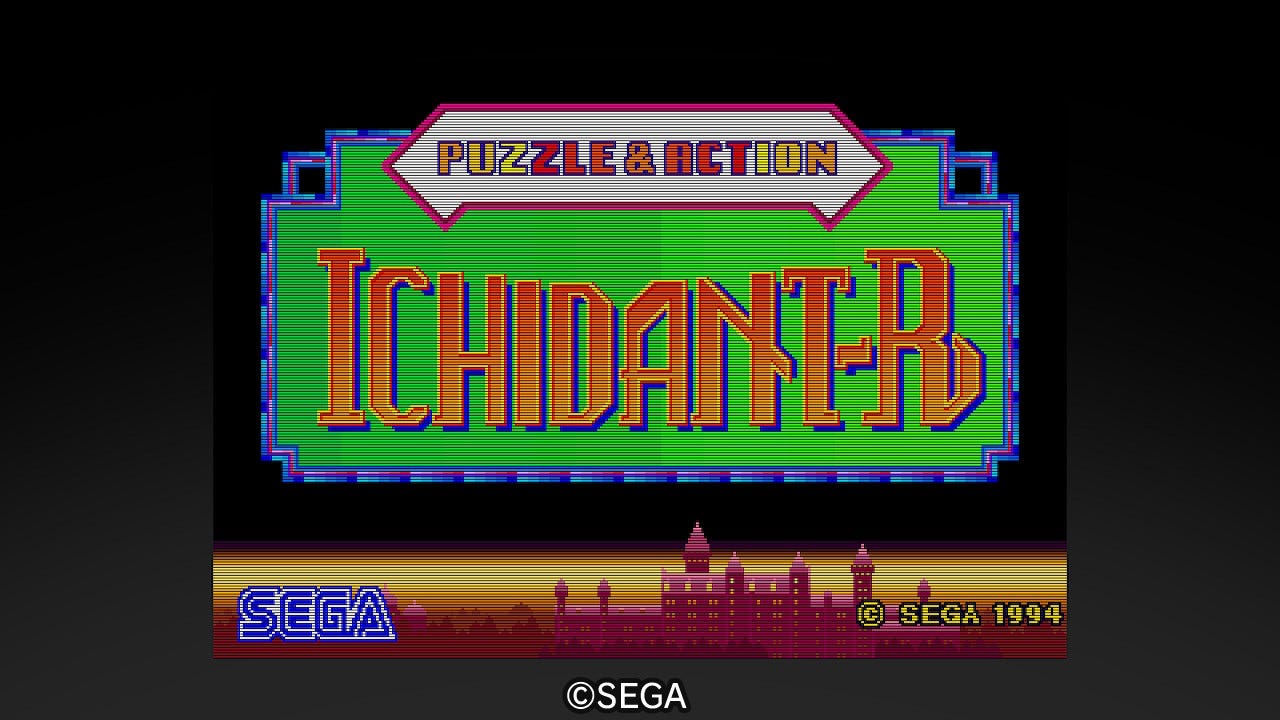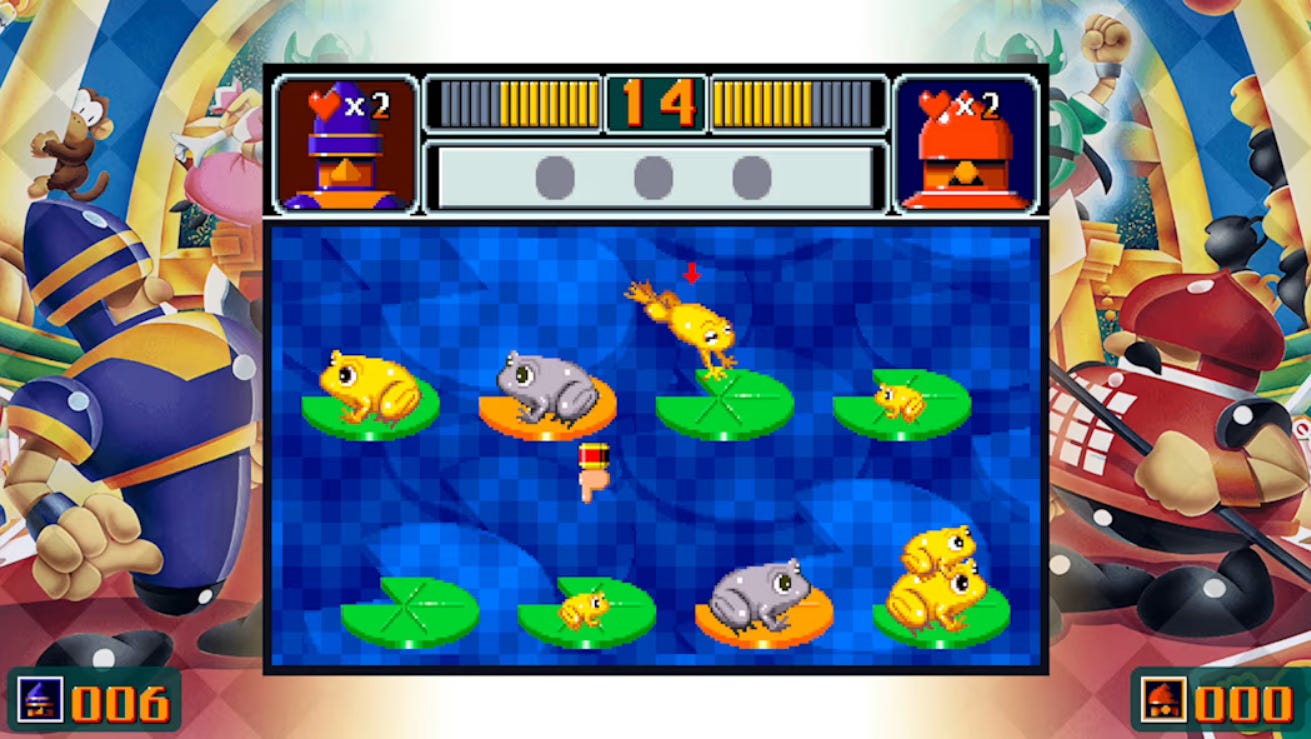Past meets present: Puzzle & Action: Ichidant-R
Sega's competitive-yet-cooperative arcade puzzle game received the Sega Ages treatment, and it's still a great time.
This column is “Past meets present,” the aim of which is to look back at game franchises and games that are in the news and topical again thanks to a sequel, a remaster, a re-release, and so on. Previous entries in this series can be found through this link.
In 1990, Sega released the stealth-action arcade game, Bonanza Bros. The goal of this game was to evade, shoot, or smack right in the face the guards who were in between you and whatever the levels’ treasure to be stolen was, and then rush off to the rooftop where your escape blimp was waiting to take you and that treasure away. It was ported pretty much everywhere, with Sega not worrying so much about keeping it on just their own platforms — Master System and Genesis, of course, but also PC Engine CD, Atari ST, Sharp X68000, Amiga, Commodore 64, and so on as well — but for some reason, despite the constant porting and sticking in the top 25 arcade cabinets in Japan for a few months in its release year, it never received a direct sequel.
Instead, Sega made a spin-off competitive and cooperative puzzle series that took place with the protagonists, Robo and Mobo, placed in different theme worlds. Puzzle & Action: Tant-R features the pair not as stealthy thieves this time, but as detectives, chasing after an escaped prison inmate. To catch up to and capture him, the pair must successfully play a whole bunch of minigames, the completion of which will move you along to the next stage and more difficult versions of the same games. Losing lives is easy, since you drop one whenever you fail in one of these games, whether because you ran out of time or made the wrong kind of move or play. Expect to spend a lot of quarters if you find one of the Puzzle & Action games out in the wild and want to complete the thing.
Tant-R isn’t one of Sega’s better-known properties, possibly because it’s a spin-off to a one-shot arcade game that released before the Genesis had become a significant player overseas. It also, unlike its own sequel, didn’t release internationally for years after its initial launch. Puzzle & Action: Ichidant-R, however, did get an overseas release — though, not one in North America. And then that game’s sequel, Puzzle & Action: Treasure Hunt, did get a North American release, but only in arcades: the console port to the Saturn remained in Japan alone, where the system actually sold relatively well. Which is a long way of saying that the entire Puzzle & Action trilogy isn’t exactly a commonly known Sega franchise.
There have been some attempts after the fact to at least keep the series alive, however, and introduce it to a broader audience. Both Bonanza Bros. and Tant-R (with some of Ichidant-R’s games added in) were included in the Playstation 2’s Sega Classics Collection, which re-released and remastered classic Sega titles with what the marketing described as “enhanced graphics and sound.” Both of those titles, as well as Ichidant-R, were put on the original Astro City Mini cabinet in their original forms. The most high-profile re-release, however, was that of Ichidant-R as part of the 2019 Sega Ages line for the Switch. It’s the only time any of them were released as a standalone, and Sega gave it the same kind of special, customizable, and complete treatment they did for every other title in the 2019 line.
Both the arcade and Mega Drive editions of Puzzle & Action: Ichidant-R are included in its Sega Ages re-releases, with one of the differences (outside of graphical quality and color palettes and all that) being that the Mega Drive edition supports a four-player mode, and includes a quest mode, as well. So, you’re truly getting two different versions of the game here, not just two of the same game running on different hardware.
Ichidant-R uses a medieval theme, so you’re once again in control of Robo and Mobo, though, this time they’re armored up and equipped with swords. A princess has been kidnapped, and it’s now their job to rescue her. They could just attack the guards, which they do before exiting any part of one of the game’s four stages, but they can’t do that for some reason until after solving four puzzles first. The video below gives you a little bit of an indication of how each stage works:
First, your character (or characters in two-player mode) walk into a room of the castle. They’re then presented with four possible puzzles to play at a time, and you try to stop on the highlighted game that you want to play by pressing the button at the correct time. Then you play that game, which will fall into one of a few categories: barrage (like with the UFOs you’re trying to shoot down), concentration (like in the above video, where you attempt to follow the movement of a woman behind closed windows to discover which one she stopped behind), picture searching (such as when you attempt to “build” the rocket with the missing pieces scattered among far more that don’t fit), puzzle (trying to maneuver all three golden frogs onto the golden lily pad, in order of height from largest to smallest), and counting (you count things).
There are 20 games in total, and you’ll go through all of them more than once — more than twice, really. You need to complete four games per room, and the further you get into the game, the more rooms there are to complete. Which means you won’t get through all 20 games in the final stage four, for instance, but you’re going to get damn close, and that’s after having already played many of them a few times.


The way the game handles this repetition is by ensuring that every repeat play is more difficult than the last one. Those UFOs you shot down in an earlier stage? Now they move even more erratically, and also have more health. And no, you don’t have more time to get the job done now, either. More frogs to complicate the lily pad puzzle. More coins to pick up with the train whose tracks you’re manipulating to lead it to said coins. More symphonies for you to guide the conductor through with quick-paced button presses, more complicated patterns to follow and repeat, that woman behind the window moves faster and faster, more rice crackers to watch being flipped while you attempt to see which two are the same… just more of everything, and faster, and less forgiving.
There’s a bit of a WarioWare vibe to all of this, but not to the point where you could say WarioWare absolutely took from Puzzle & Action. For one, these are minigames, not microgames, and the frenetic nature of those plays a significant role in making WarioWare what it is. However, the oddball vibes and timed nature of it all certainly do bear more than a passing resemblance, insofar as trying to understand just what Ichidant-R is goes.
Another thing that separates the two is that Ichidant-R is competitive, in the sense that it’s tracking your wins against the dubs of the second player, and will reward the winner of the most puzzles with the princess’ hand in marriage and is named the victor. But for the vast majority of the experience, it’s really more a cooperative experience where your desire to win works in favor of the two of you. You need to win X number of rounds per puzzle in order to have actually completed it, with that figure growing depending on the stage: later stages can require additional victories compared to the same puzzle in an earlier stage. Who gets those wins doesn’t matter, though, so long as someone gets it. So, if you’re bad at a particular puzzle, but the other player can crush it? That’s fine. Split right down the middle in a highly competitive bout? Also fine, so long as you get what you need in the end to move on.
My wife and I played Ichidant-R together, and there were some puzzles where I just couldn’t keep track of what I needed to fast enough, before time ran out. There’s a puzzle, alluded to earlier, where rice crackers are cooking on a grill, and being flipped. As they’re flipping, you need to spot which two are the same on both sides, based on a few different visual cues. She was on the ball every time, figuring out which two matched before I could figure out which ones it might even be, so she carried the day on those. But then there was a puzzle where the goal was to sharpen pencils that were longer and longer the further into the game you were, before time ran out, and you did this by rotating the analog stick as fast as possible. At first, I was just sharpening faster than she was and winning that way, but by the end of the game, when the pencils were at their longest and time was at its shortest, my rotation speed is the only reason we even managed to progress, because she was as far away from finishing that as I was the rice cracker puzzle. Competitive, yes, but in a way that drives the success of a team, which is what you actually are if you plan to see the end of Ichidant-R.
If you’ve never tried playing a Puzzle & Action game before — a perfectly understandable circumstance, considering none of the home ports were released internationally for years — Ichidant-R is right there for all of $8, in its definitive Sega Ages form, on the Switch. It’s a wonderful little competitive/cooperative game, and not quite like much else out there: if you’ve got to pull WarioWare out as a comp while admitting even that’s not right, you know this one is kind of out there. Be prepared for some repetition, given there are just the 20 games to go through again and again, but this one’s a couch co-op winner even with that limitation in place.
This newsletter is free for anyone to read, but if you’d like to support my ability to continue writing, you can become a Patreon supporter, or donate to my Ko-fi to fund future game coverage at Retro XP.



